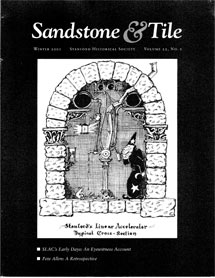
Handy Links
SLAC News Center
SLAC Today
- Subscribe
- Archives: Feb 2006-May 20, 2011
- Archives: May 23, 2011 and later
- Submit Feedback or Story Ideas
- About SLAC Today
SLAC News
Lab News
- Interactions
- Lightsources.org
- ILC NewsLine
- Int'l Science Grid This Week
- Fermilab Today
- Berkeley Lab News
- @brookhaven TODAY
- DOE Pulse
- CERN Courier
- DESY inForm
- US / LHC
SLAC Links
- Emergency
- Safety
- Policy Repository
- Site Entry Form

- Site Maps
- M & O Review
- Computing Status & Calendar
- SLAC Colloquium
- SLACspeak
- SLACspace
- SLAC Logo
- Café Menu
- Flea Market
- Web E-mail
- Marguerite Shuttle
- Discount Commuter Passes
-
Award Reporting Form
- SPIRES
- SciDoc
- Activity Groups
- Library
Stanford
Around the Bay
Fifty Years Ago in April
In April of 1960, participants in the proposed "Project M," a two-mile linear accelerator to be located at Stanford University, were in the middle of a long and arduous battle to make the project a reality. The effort suffered a blow that month, when initial plans to approve and fund it were rejected. But April was also a historic and happy time for the project, as it was the month when the team selected the official site for Project M, and the future home of SLAC.
One year earlier, in the spring of 1959, President Eisenhower announced his support for Project M at a black tie dinner honoring American scientists. He emphasized the benefit it could bring to America. But Eisenhower, a Republican, hadn't told the Democratic congress about his announcement beforehand, and it fanned the flames of partisan politics surrounding the nascent project. Eisenhower's public support put Project M in the national spotlight, and the following year saw members of its planning group testifying before congress and facing tough questioning. Those men included Edward Ginzton, the Project M Director, Wolfgang "Pief" Panofsky, key Project M proponent and SLAC's first director, and Robert Moulton, who was hired to evaluate Stanford's financial position and ended up playing a pivotal role in Project M's creation.
By January of 1960, potential sites for Project M were up for discussion. Two proposed locations would have taken the project far away from its roots at Stanford, or even out of California. Another would have placed it on Stanford property south of the Junipero Serra Freeway.
The Stanford Daily reported in January 1960 that Ellison Shute, then director of the San Francisco office of the Atomic Energy Commission, or AEC, stated, "the AEC is firmly committed to building the linear accelerator at or near Stanford because Stanford's academic team is believed to be only one in the nation with the technical know how to operate the huge atom smasher." But geological evaluations of the proposed location revealed rocky terrain that would significantly drive up the cost of digging a two mile tunnel 35 feet underground.
In February, the AEC (which preceded the Department of Energy) announced a potential compromise―put Project M on a smoother stretch of land one half mile south of Sand Hill Road. Stanford had planned to lease the land for housing developments as a way to generate income, but the university relinquished those plans in favor of Project M.
On February 23, 1960, the university Board of Trustees announced their approval of the Sand Hill site. But in Washington, the linear accelerator hadn't been included in the Federal budget for the fiscal year beginning July 1. The accelerator wasn't off the table, according to Representative Chet Holifield of California as quoted in The Stanford Daily archives, but with the desire to balance the budget in an election year, the prospects for Project M were discouraging. "Lots of things come before a linear accelerator," Holifield was quoted as saying.
Still the AEC pursued funding for Project M. The commission wanted Project M located on Sand Hill Road, according to the April 6, 1960 Daily, and it asked congress for a grant of $153 million, which included building cost and first year operation. Within a week the $153 million proposal had been rejected.
Project M was down, but not out. Congress granted the project $3 million for design and engineering studies. Eisenhower spoke out once again in favor of funding the project, though he would leave office, replaced by John F. Kennedy, before the funding would go through in 1961. There were still those in Washington cheering Project M onward, and those who didn't care to see it come to fruition. Over the course of the following year and a half, proponents of Project M fought hard for its survival, and it wasn't until the fall of 1961 that congress would authorize the AEC to negotiate a contract with Stanford University, and allot an estimated $114 million for construction.
For more detail into the progression of events between 1957 and 1962, see the SLAC Archives collection of clippings from the Stanford Daily, or read Bob Moulton's personal account.
—Calla Cofield
SLAC Today, April 30, 2010
